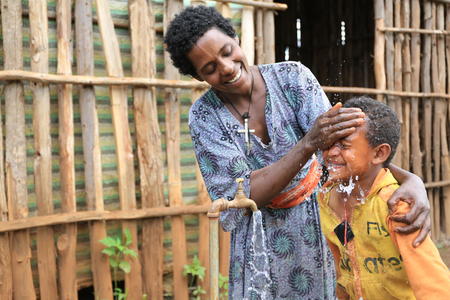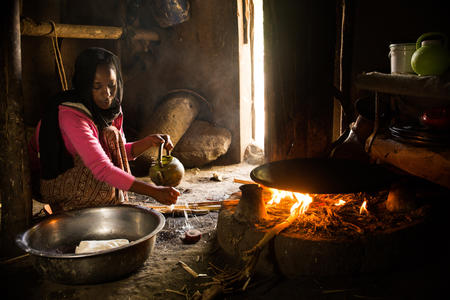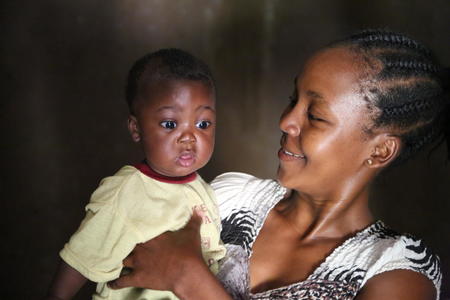From commitments to action: what will it take to integrate WASH and nutrition in Ethiopia?

Globally, more than one in five children are stunted. In Ethiopia, it's more than one in three. With evidence growing on the connections between undernutrition and poor water, sanitation and hygiene, WaterAid and Action Against Hunger investigated how to tackle these two challenges, at policy level and on the ground. Tseguereda Abraham, Teklemariam Ayalew and Rebecca Heald discuss their case study.
Although Ethiopia has made some significant progress in water, sanitation and nutrition in the Millennium Development Goal era, it still has a long way to go. 39.1% of people have access to at least basic water, 7.1% have access to at least basic sanitation, and just 1% have access to at least basic hygiene.1
Undernutrition is a huge challenge and a threat to public health. One in ten children under five in Ethiopia are acutely malnourished, and nearly one in four are underweight. More than one in three are stunted, irreversibly damaging their physical and cognitive development, and limiting their future prosperity.2,3
Access to safe water, sanitation and hygiene (WASH) is a fundamental determinant of maternal and child health and nutrition, especially during the first 1,000 days of a child’s life from conception to age two. Global estimates suggest that a quarter of all stunting is attributed to five or more episodes of diarrhoea during the first two years of life.4And studies indicate that poor sanitation is the second leading risk factor for stunting worldwide.5
WaterAid Ethiopia and Action Against Hunger (ACF) Ethiopia each prioritise integration of WASH and nutrition systems in their strategies, understanding the strong connections between poor WASH and undernutrition (PDF), and the progress that coordinating work on the two could achieve.
Assessing the successes, challenges, opportunities and recommendations
In 2017, ACF, SHARE and WaterAid researched and produced Recipe for Success, in which we analysed the approaches governments (including Ethiopia’s) and donors are taking to integrating nutrition and WASH. We highlighted ways in which progress was being made, and called on decision makers to shift mindsets, change ways of working and invest in effective integration to improve child health.
Since launching the report, WaterAid Ethiopia and ACF Ethiopia have been collaborating to bring attention to the issue, including engaging with the WASH Ethiopia Movement and the Ethiopian Coalition for Scaling Up Nutrition (SUN). To inspire and guide further action at national and global levels by governments and donors, we gathered lessons from three countries that have made progress in driving closer collaboration and integration of national nutrition and WASH policies and programmes: Madagascar, Cambodia and Ethiopia (PDF).
To assess the successes, challenges and opportunities, and make recommendations for greater collaboration between WASH and nutrition in Ethiopia, we interviewed key stakeholders from national and sub-national government, bilateral and multilateral donor agencies, and NGOs. In our case study – From commitments to action: accelerating integration of nutrition and water, sanitation and hygiene (WASH) in Ethiopia (PDF) – we explore how progress at policy level is translating into action at the district level.
Ethiopia has committed to tackle malnutrition
We found strong signs of progress at policy level. The Government of Ethiopia has in some ways recognised the importance of WASH to combating undernutrition, and has recently made some important political commitments to an integrated, multisectoral approach to tackling it. WASH is included as part of the multisectoral approach in the National Nutrition Programme II (2016–20), which aims to improve cross-ministerial coordination. And the Seqota Declaration of 2015, named after a town infamous as the epicentre of the catastrophic famines in 1974 and 1985, represents a high-level, public commitment to scaling up a nationwide, integrated approach intended to end stunting by 2030.
The Declaration reflects the Government’s strong commitment to improving nutrition and its recognition of nutrition's role in propelling sustainable development. The Seqota woreda (district) is testing a multisectoral approach to nutrition, modelling the challenges of bringing the different actors together. With a historic vulnerability to drought and food insecurity, Seqota strongly feels the challenge of undernutrition, and the impact of a successful multisectoral initiative will be enormous.
The OWNP (ONE WASH National Program) is Ethiopia’s sector-wide approach, a multi-stakeholder platform with an integrated plan for achieving universal access. The ONE WASH Phase II has identified the importance of nutrition and aims to scale up the Baby WASH Guideline that focuses on safe water, safe disposal of child faeces and providing protective environments.
But there are challenges in implementation
Our key recommendations for the sector focus on the follow-through. We emphasise that nutrition-sensitive WASH must be a top priority, backed up by enhanced coordination, accountability, budget allocation, capacity building and reliable data on hotspots of undernutrition and poor WASH.
The woreda, or district, is the lowest level of government structure in Ethiopia where WASH and nutrition integration can be implemented. To do so effectively, it is critical to consider nutrition indicators when planning for WASH investments. And WASH and nutrition actors at woreda level must have clarity on roles and responsibilities. They should also understand why it’s important to integrate WASH and nutrition, and how that can be achieved.
To increase accountability of actors at all levels, reporting on integrated WASH and nutrition action should be improved. Woredas should support the implementation of integrated WASH and nutrition programmes, including with geographic targeting of WASH projects to malnutrition hotspots.
The ONE WASH woreda-level coordination structures should be extended to include nutrition department woreda experts, and the programme should report on joint targets and plans.
Accelerating multisectoral action is crucial
Evidence is growing that suggests the links between poor WASH and nutrition are even stronger than previously believed. To overcome the underlying and indirect causes of malnutrition and reduce stunting, action across multiple sectors is crucial.
Ethiopia's commitment at the highest levels is encouraging, but a lot remains to be done in translating that to action and results, through joint planning, targeting and monitoring both nutrition and WASH indicators.
Read our full recommendations and case study
Tseguereda Abraham is Head of Sector Strengthening in WaterAid Ethiopia, Teklemariam Ayalew is WASH Technical for Advisor Action Against Hunger Ethiopia, and Rebecca Heald is Digital Editor at WaterAid UK and a researcher on this project.
References
1. WHO/UNICEF (2017). Progress on drinking water, sanitation and hygiene: 2017 update and SDG baselines. Licence: CC BY-NC-SA 3.0 IGO.
2. Scaling Up Nutrition (2018).Ethiopia Country Profile 2018.
3. Central Statistical Agency (CSA) [Ethiopia] and ICF (2016). Ethiopia Demographic and Health;Survey 2016. Addis Ababa, Ethiopia, and Rockville, Maryland, USA: CSA and ICF.
4. Walker CL, Rudan I, Liu L et al. (2013). Global burden of childhood pneumonia and diarrhoea. The Lancet 381 (9875):1405-16.
5. Danaei G et al. (2016). Risk Factors for Childhood Stunting in 137 Developing Countries: A Comparative Risk Assessment Analysis at Global, Regional & Country Levels. PLoS Medicine;13(11): e1002164.


